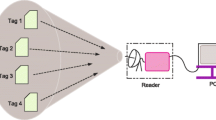Abstract
In the passive radio frequency identification systems, dynamic frame slotted ALOHA framework has been popularly deployed by the industry driven EPCGlobal C1G2 standard to solve tags collision problem, where tags collision is mainly caused by the mismatched frame length leading to simultaneous responding tags in one same time slot and one reader needs to continuously select the appropriate frame length for effectively identifying tags. Obviously, the throughput improvement comes at the expense of frequent adjustments leading to large computation load and consumption. In order to decrease the frame length adjustment times and catch hold of the satisfactory throughput, this paper proposes a segment-by-segment ALOHA algorithm, where one frame is composed of slot-segments and each slot-segment is composed of s L continuous time slots with three scenarios as collision occupant, empty occupant and singleton occupant. To count these three scenarios in n L slot-segments, the corresponding adjustment operations with exclusive estimator to deal with the unread tags is further introduced. Compared with the state-of-the-art ALOHA-based algorithm in slot-by-slot fashion, the proposed one dramatically decreases the frame length adjustment times and partly increases the identification speed up to 420 tags/s with the throughput around 36% which is very close to the theoretical maximum 36.8%.







Similar content being viewed by others
References
Enrique, V., Antonio, A., & Carlos, C. (2015). Evolution of RFID applications in construction: A literature review. Sensors, 15, 15988–16008. doi:10.3390/s150715988.
EPC radio-frequency identity protocols, class-1 generation-2 UHF RFID protocol for communications at 860 MHz–960 MHz, Version 2.0.0, EPC Global, November 2013.
ISO/IEC 18000-6:2010, Information technology–radio frequency identification for item management–Part 6: Parameters for air interface communications at 860 MHz to 960 MHz. International Organization for Standardization, April 2011.
Chen, W. T., & Lin, G. H. (2006). An efficient anti-collision method for tag identification in a RFID system. IEICE Transactions on Communications, E89-B(12), 3386–3392. doi:10.1093/ietcom/e89-b.12.3386.
Knerr, B., Holzer, M., Angerer, C., & Rupp, M. (2008). Slot-by-slot minimum squared error estimator for tags populations in FSA protocols. In Proceedings of 2nd international EURASIP workshop on RFID (pp. 1–13).
Floerkemeier, C. (2006). Transmission control scheme for fast RFID object identification. In Proceedings 4th annual IEEE international conference pervasive computing and communications workshops (pp. 457–462). doi:10.1109/PERCOMW.2006.136.
Chen, W. T., & Hung, L. G. (2006). An efficient scheme for multiple access in a RFID system. In 2006 international conference on wireless networks, (pp. 160–163).
Alonso, J. V., Delgado, V. B., Lopez, E. E., & Gonzalez-Castano, F. J. (2011). Multi-frame maximum-likelihood tag estimation for RFID anti-collision protocols. IEEE Transactions Industrial Informatics, 7(3), 487–496. doi:10.1109/TII.2011.2158831.
Su, W., Alchazidis, N. V., & Ha, T. T. (2010). Multiple RFID tags access algorithm. IEEE Transactions on Mobile computing, 9(2), 174–187. doi:10.1109/TMC.2009.106.
Schoute, F. C. (1983). Dynamic frame length ALOHA. IEEE Transactions on Communications, 31(4), 565–568. doi:10.1109/TCOM.1983.1095854.
Vogt, H. (2002) Efficient object identification with passive RFID tags. In Pervasive ‘02 proceedings of the first international conference on pervasive computing, London, UK (pp. 98–113). doi:10.1007/3-540-45866-2_9.
Choi, S. S., & Kim, S. (2009). A dynamic framed slotted ALOHA algorithm using collision factor for RFID identification. IEICE Transactions on Communications, E92.B(3), 1023–1026. doi:10.1587/transcom.E92.B.
Khandelwal, G., Lee, K., Yener, A., & Serbetli, S. (2007). ASAP: A MAC protocol for dense and time-constrained RFID systems. EURASIP Journal on Wireless Communications and Networking, 1, 1–13. doi:10.1155/2007/18730.
Chen, W. T. (2014). A fast anticollision algorithm for the EPCglobal UHF class-1 generation-2 RFID standard. IEEE Communication Letters, 18(9), 1519–1522. doi:10.1109/LCOMM.2014.2334317.
Chen, W. T. (2014). A feasible and easy-to-implement anti-collision algorithm for the EPCglobal UHF class-1 generation-2 RFID protocol. IEEE Transaction on Automation Science and Engineering, 11(2), 485–491. doi:10.1109/TASE.2013.2257756.
Chen, W. T. (2016). Optimal frame length analysis and an efficient anti-collision algorithm with early adjustment of frame length for RFID systems. IEEE Transactions on Vehicular Technology, 65(5), 3342–3348. doi:10.1109/TVT.2015.2441052.
Chen, W. T. (2009). An accurate tag estimate method for improving the performance of an RFID anticollision algorithm based on dynamic frame length ALOHA. IEEE Transactions on Automation Science and Engineering. doi:10.1109/TASE.2008.917093.
Duan, L. T., Zhang, X. Y., Wang John, Z. Z., & Duan, F. (2016). A grouping-paralleling identification and authentication algorithm for RFID system in EPCglobal G2V2. Journal of Computational and Theoretical Nanoscience, 13(5), 3183–3196. doi:10.1166/jctn.2016.4973.
Cook, S. A., & Reckhow, R. A. (1979). The relative efficiency of propositional proof systems. The Journal of Symbolic Logic, 44, 36–50. doi:10.2307/2273702.
Buss, S. (2015). Quasipolynomial size proofs of the propositional pigeonhole principle. Theoretical Computer Science, 576, 77–84. doi:10.1016/j.tcs.2015.02.005.
Acknowledgements
This research is supported by National Natural Science Foundation of China (61472271 and 61503273), Key Scientific and Technological Projects of Shanxi Province (20130321001-09 and 2007031129).
Author information
Authors and Affiliations
Corresponding author
Rights and permissions
About this article
Cite this article
Duan, L., Zhang, X., Wang, Z.J. et al. A Feasible Segment-by-Segment ALOHA Algorithm for RFID Systems. Wireless Pers Commun 96, 2633–2649 (2017). https://doi.org/10.1007/s11277-017-4316-y
Published:
Issue Date:
DOI: https://doi.org/10.1007/s11277-017-4316-y




